There are various reasons why you may need to get in touch with a call center. Perhaps you’ve bought a faulty product and want a refund or need tech support when setting up the new conference call services you’ve recently signed up for.
Think back to your last experience with a call center. Did you spend a long time on hold? Did you get connected to an agent who immediately helped with your query? If so, it all came down to an efficient call center call flow – and that’s likely thanks to call queueing.
Call queueing can revolutionize the way that call centers operate. It can reduce hold times, improve customer satisfaction, and even boost employee retention.
This article will look at what call queueing is, the causes and solutions to long call queues, and some of the most significant benefits that call queueing can have for your business.
What is call queueing?
Call queueing is the process of placing incoming calls into a virtual queue so they can be answered in the order in which the callers place their calls. For example, many conference call services boast a call queue feature, enabling companies to answer calls on a ‘first come, first served’ basis.
Also referred to as a First In, First Out (FIFO) system, it ensures that no caller is waiting longer than necessary when there are more incoming calls than agents available to answer them.
Call queueing can also occur when trying to direct calls to the right department or a specific agent. Often, a call queueing system will feature the option to play a personalized message to callers as they wait. This is done to reassure callers that their call will be taken soon and will often advise them how many callers are in the queue in front of them.
If call abandonment rate is one of the key call center metrics you measure, it’s a good idea to reassure callers that queues are moving quickly, encouraging them to stay on the line rather than hanging up.
Many call queues are preceded by an interactive voice response (IVR) feature. These determine how to route incoming calls based on the caller’s needs. An automated interface identifies what a caller is enquiring about by giving them predetermined options to choose from.
For example, calls regarding billing can be transferred to the accounts department, while calls about how to stop spam texts can be directed to technical support. This ensures callers are placed in the right call queue and that no customer is waiting on hold for too long.
While call queueing won’t eliminate the need for callers to wait on hold, it should help to reduce the percentage of callers who have to wait and how long they have to wait.
What causes long call queues?
Various factors can contribute to long call queues in call and contact centers.
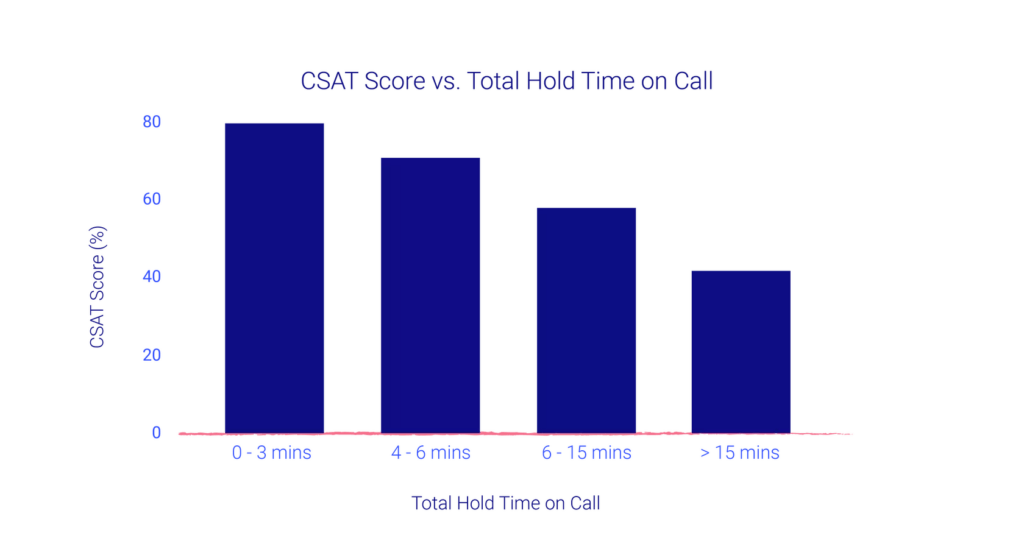
Research shows that customer satisfaction (CSAT) scores correlate directly with the time a caller spends on hold. The longer a caller had to wait, the lower the CSAT score.
With that in mind, tackling the factors that lead to long call queues can be the key to improving customer satisfaction.
1. Peak calling season
Some times of the year are likely to be busier for your call and contact centers than others. For example, retailers will likely see an influx of calls around peak trading times, such as Black Friday and the January sales.
You may also see an increase in calls if you’ve recently run a new advertising campaign or are currently offering promotional codes. So, try and plan for these peak calling seasons as effectively as possible.
This could involve looking at historical call volume data for previous years and making more agents available during times when call volumes have been historically high. It’s also crucial to communicate with other departments, such as marketing, so you’re aware of any activity that could increase call volumes.
Evaluating your customers’ behavior can also help reduce long call queues. You may find that there are particular days of the week or times of the day when you experience higher call volumes. Ensuring sufficient agents are available during these times can help to reduce call queue sizes.
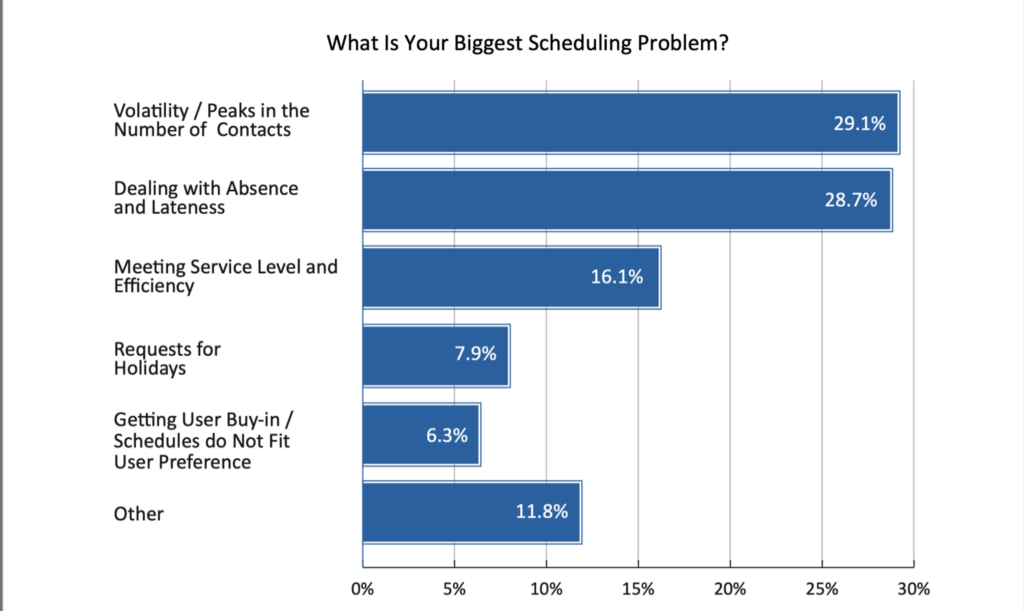
Image Sourced from callcentrehelper.com
In a survey by Call Centre Helper, over 29% of respondents reported that volatility in the number of contacts posed the biggest challenge when scheduling contact center agents. So, it’s easy to see why unexpectedly high call volumes would lead to lengthy call queues.
It’s worth mentioning that making more call center agents available isn’t the only way to manage call queues. Providing alternative communication methods, such as live chat and email support, can help to alleviate the strain on call center teams.
2. Undertrained agents
It’s essential that call center staff can identify problems and suggest solutions quickly while still providing excellent customer service. The less time your agents spend on the line with each caller, the quicker they can work through the call queue.
While some people have a natural talent for dealing with callers in this way, it’s unreasonable to expect every agent to be able to hit every call out of the park the first time. That’s why it’s essential to provide adequate training for your call center agents. This ensures they stay up to speed with the latest techniques and are armed with the information they need to help their callers.
Many contact center platforms provide elegant solutions to help with the training of agents. Features such as coaching playlists allow you to provide examples of what your agents should and shouldn’t be doing on their calls to help them move along smoothly and swiftly.
Some platforms even offer real-time coaching features, such as assist cards, which allow contact center managers to jump in and help agents who may be struggling. This can help turn calls around quickly, getting them back on track and keeping the call queue moving.
Providing adequate training materials is essential in keeping your agents up to speed. Webinars and online knowledge bases are excellent tools for training staff, especially if you employ and manage remote teams. It’s also important to ensure that new hires are onboarded effectively and have all the training they require to get up to speed quickly.
3. Lack of self-service options
Customers are increasingly interested in using self-service options to resolve issues. In fact, the number of online shoppers who reported wanting to resolve issues themselves increased from 50% in 2020 to 60% in 2021, according to research from Gladly.
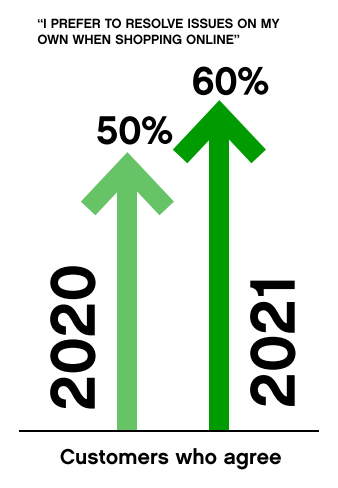
Not only are self-service options desired by customers, they also help to reduce call queue lengths. A lack of self-service options can lead to lengthy call queues and dissatisfied customers.
Customer self-service options can take many forms. An IVR system can give customers the opportunity to perform relatively simple tasks on the phone, such as paying a bill or receiving a shipping update, without having to speak to an agent.
Online knowledge databases, FAQ pages, and tutorials can all provide customers with answers directly from your webpage, without the need for a phone call to customer services.
Offering support through other communication channels can also help to reduce call queues. Live chat, chatbots, email, and SMS can all be used as alternative communication channels to offer customer support.
Five effective ways to help manage call queues
Managing call queues is essential to providing timely customer service and improving your CSAT scores. Here are some of the most effective ways businesses can manage their call queues.
1. Train cross-functional agents who can step up
There may be times when you receive an unexpectedly high number of incoming calls. In these scenarios, it can be easy for call queues to grow as agents become overwhelmed. One way to combat this is to train contact center agents in communication across multiple channels.
Therefore, if call volumes are creeping up, agents can be transferred from other communication channels that are less busy to help reduce the strain. An omnichannel contact center will often have agents responsible for answering email queries, manning live chat channels, and even responding to queries on social media.
Having these agents be multi-skilled means they can pivot quickly and easily to the channel that requires them the most, reducing wait times across the board.
It can also be beneficial to cross-train agents in a variety of business areas. This reduces the need to transfer calls to other departments, as one agent can handle multiple queries of different natures should they arise. This reduces the instances of callers being placed back into queues once their call has already been answered.
2. Take advantage of IVR
Interactive voice response (IVR) systems are an essential tool in managing call queues. Firstly, IVR can provide a powerful self-service tool for callers, which can eliminate the need to speak to an agent in many cases. This can greatly reduce the number of callers in a queue.
In addition, an IVR system is useful in gathering information about a caller before they speak to an agent. Details such as order numbers, contact information, and the nature of a query can all be obtained by an IVR system, saving the agent time once the call is connected. This helps to reduce average handling times, allowing agents to work through more calls and ultimately reducing call queues.
Finally, IVR systems can be instrumental in ensuring that calls are directed to the correct agents. If a caller is connected to the wrong department, they may have to be placed back into a call queue. Ensuring that they speak to the right person the first time, every time, reduces the number of callers joining call queues and improves customer satisfaction as a result.
3. Set maximum hold times
Keeping callers on hold for a long time is a sure fire way to reduce your CSAT scores and increase call abandonment rates. In fact, some research shows that 50% of callers will abandon a call after 95 seconds on hold.
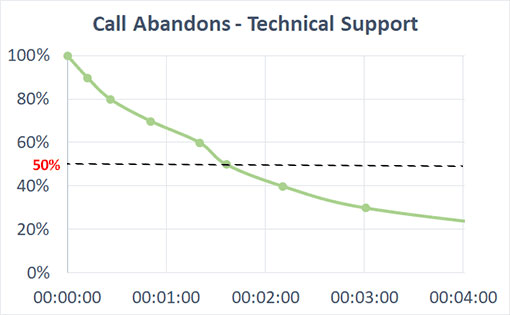
Image sourced from callcentrehelper.com
Maximum hold times can reduce the instances where a caller is left on hold indefinitely. These will automatically transfer a caller to voicemail or another office location once they’ve been on hold for a predetermined length of time.
Although this is a less appealing solution than connecting calls to the optimum agent, it is a better solution than leaving callers on hold for a long time. Voicemail messages can then be responded to once call volumes have reduced and agents have time to dedicate the appropriate resource to the caller.
4. Offer automated call-backs
Automated call-backs are another useful feature of business phone systems that can help to manage call queues. They allow callers to hold their place in a queue, without the need to sit with their phone listening to hold music.
Automated call-backs can be offered as a service through an IVR system, giving callers the option to go off and focus on other tasks, secure in the knowledge that they’ll receive a call from an agent once they’ve reached the front of the queue.
5. Use hold music
If you absolutely have to leave your callers on hold, then it’s in your best interest to ensure they have something nice to listen to while they’re waiting. Listening to silence on the other end of the line can make callers feel like they’ve been on hold longer than they actually have been or that they’ve been abandoned altogether.
Combining hold music with custom messages is the best way to keep your callers on the line. These messages can be used to let a caller know what their place in the queue is or simply that their call is important to you and will be dealt with shortly.
Research has shown that only 2% of callers drop off the line when left on hold with music and a pre-recorded message, compared to 53% of callers who were left listening to silence.
How a call queueing system helps in managing call center flow
Managing call center flow is crucial to keeping your customers satisfied, reducing the size of call queues, and minimizing call waiting times. A call queueing system is one of the best ways to maintain a healthy call center call flow.
1. Minimizes customer hold time
Having to wait on hold for a long time is one of the biggest annoyances for customers, with 57% of people reporting long hold times as a frustration. So, in order to provide a good customer experience, businesses should do as much as possible to reduce hold times for customers calling their contact centers.
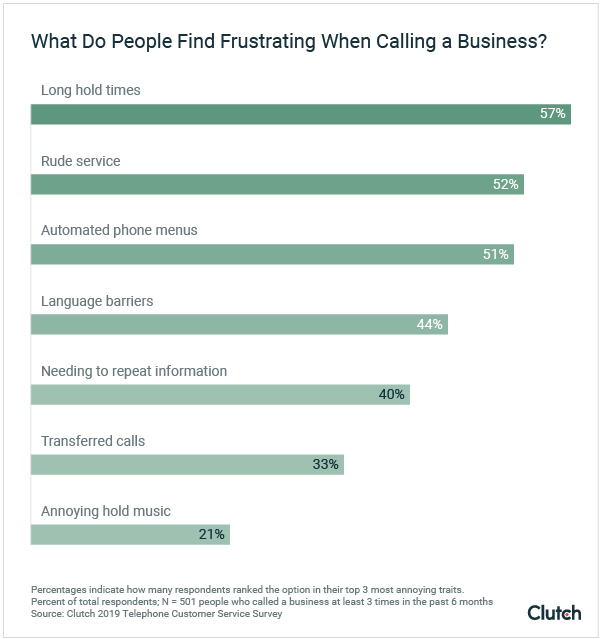
Image Sourced from clutch.co
Utilizing a call queueing system is one way customer hold times can be reduced. An optimized call queue reduces the average handling time of calls, which in turn allows agents to answer more calls. The more calls that are being answered, the less time on average callers have to wait on hold.
An optimized call queue ensures callers are directed to the right department and speak to an agent who can resolve their issue. This eliminates the need for them to be transferred to other agents or departments.
An IVR system can help optimize call queues, gathering information from callers before they speak to an agent so they can be placed in the right queue.
2. Helps in distributing workload to team members
A call queueing system doesn’t only provide benefits for your customers, but for your contact center agents too. Proper call queue management ensures that calls are distributed evenly among groups of agents, which spreads the workload and prevents any one particular agent from becoming overwhelmed by a larger volume of calls.
What’s more, a call queueing system ensures calls are directed to the relevant department. This means that when an agent answers the call, they don’t have to explain to the caller that they’ve been connected to the wrong department and need to be transferred. This reduces the risk of dealing with irate customers, which in turn boosts employee satisfaction.
IVR systems and other call queueing tools also work to make the employee experience better for agents. Information gathered by these features can arm an agent with the critical details of their callers before they speak to them. This eliminates the need for agents to spend time gathering this information themselves, allowing them to get on with tackling the problem at hand immediately.
3. Reduces call abandonment rate
Call abandonment rate measures how many callers hang up before their issue is resolved when calling your contact center. A high call abandonment rate indicates that your customers aren’t getting the assistance they require and often goes hand-in-hand with poor customer satisfaction (CSAT) scores.
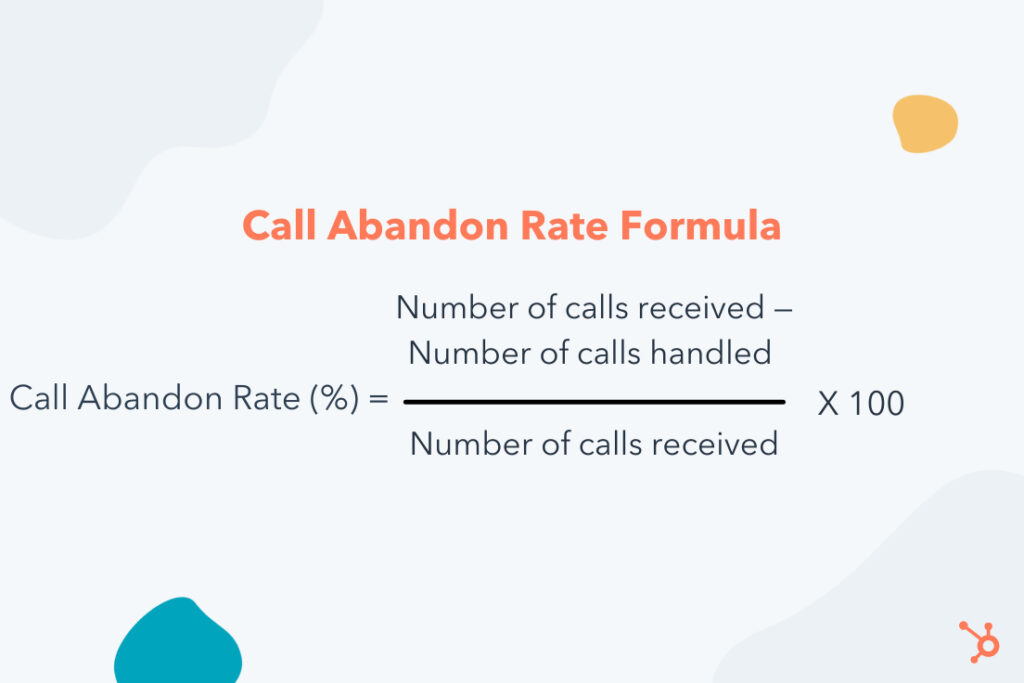
Image Sourced from hubspot.com
Reducing the amount of time that your customers are on hold reduces the chance of them hanging up before speaking to an agent. Ensuring that they’re connected to the correct agent the first time will reduce the risk of them hanging up once they’ve been connected. A call queueing system can help achieve both of these goals.
Utilizing hold music and personalized, pre-recorded messages while your customers are on hold will also help to reduce call abandonment. Again, these are features of call queueing systems that can be used to great effect.
4. Increases customer satisfaction
Achieving high levels of customer satisfaction should be a key concern for all call and contact centers. Higher customer satisfaction leads to a higher net promoter score (NPS), which means more positive word-of-mouth associated with your business and more positive recommendations.
One of the best ways to increase customer satisfaction in your contact center is to show customers that you respect their time. This means reducing the amount of time spent on hold, lowering your average handling times, and improving your first call resolution (FCR) rates.
An effective call queueing system can help in all these areas, improving the speed at which calls are answered and queries are resolved, and ensuring that callers speak to an agent that can help with their issue the first time, every time.
5. Enhances first call resolution (FCR) rates
The first call resolution (FCR) rate tracks how many customer issues are resolved during the first communication with an agent. A high FCR rate indicates that callers are being connected to the right department the first time and that their issues are being resolved without the need to repeatedly call back.
In this way, FCR correlates directly with customer satisfaction. If you’re looking to keep your customers satisfied and build a positive reputation, it’s important to achieve high FCR rates.
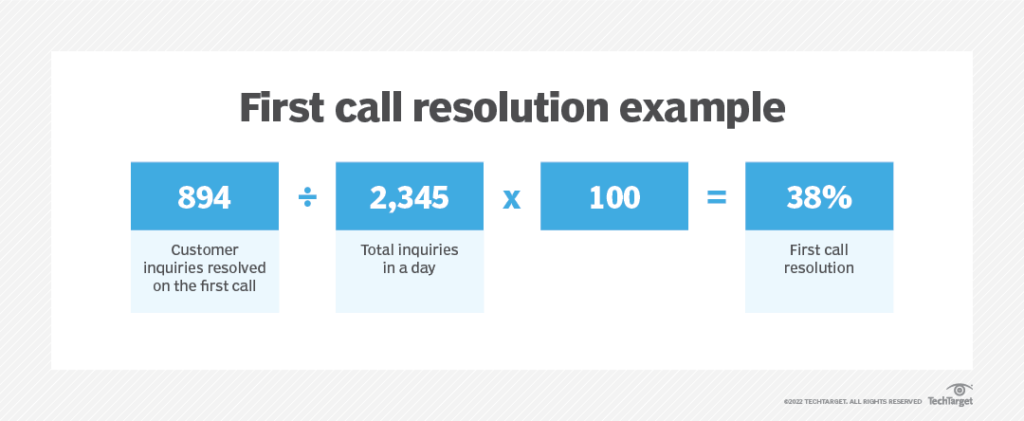
Image Sourced from techtarget.com
Not only does a good FCR rate improve customer satisfaction, it can also reduce operational costs. In addition, it has been shown to increase customer spending and boost cross-selling profits.
Calculating your customer experience ROI (return on investment) will give you an indication of how beneficial your customer experience improvements have been to your business.
A call queueing system can help to enhance your FCR rates by connecting callers with the best agent to handle their query. Details collected by IVR systems can then be used by the agent to resolve the query efficiently, arming them with as much information as possible to ensure they reach a satisfactory resolution.
6. Improves employee satisfaction
There are numerous things you can do to ensure high employee satisfaction in your contact centers, from providing the right equipment for the job to choosing the perfect method of business communication for your agents to use. You may not have realized it, but getting your call queue management right is another way to improve employee satisfaction.
A call queueing system ensures that callers are connected to an agent that can help them with whatever issue they’re having. This reduces the chances of irate customers being repeatedly transferred to the wrong department and taking their frustrations out on contact center agents.
Happier customers result in less stress for agents which, in turn, can reduce employee turnover and its associated costs.
Reducing employee churn can help your business in numerous ways. The various negative impacts of employee turnover include loss of productivity, delays to customer service, and the financial costs of onboarding replacement staff.
By using a call queue management system to improve employee satisfaction, you can help to reduce these negative impacts in other areas of the business.
Conclusion
Call queueing is a relatively simple concept, but one that can have a range of positive implications for your business by allowing you to take control of your call center call flow.
Not only can call queueing boost customer and employee satisfaction, it can improve a host of other metrics, including first call resolution (FCR), customer hold time, and call abandonment rate.
You can use various methods and tools to take control of your call flow and achieve these results. So identify the right methods for your team and see how much of a positive impact they can have for your call center and your business as a whole.

Jenna Bunnell is the Senior Manager for Content Marketing at Dialpad, an AI-incorporated cloud contact centre solutions and unified communications system that provides valuable call details for business owners and sales representatives. She is driven and passionate about communicating a brand’s design sensibility and visualizing how content can be presented in creative and comprehensive ways.


